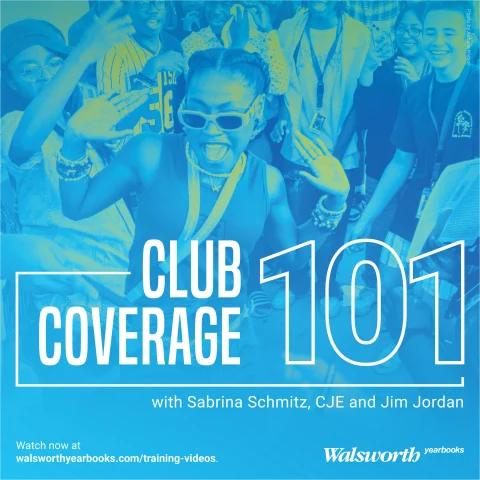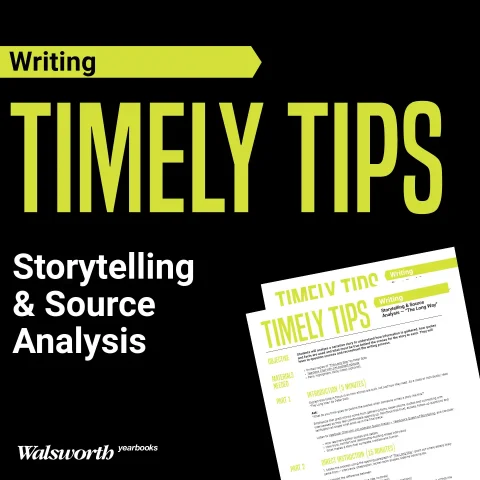It’s the time of year when many yearbook staffs are finishing their books. The only problem? There are still months left in the school year! If you’re looking for a journalism skill-building activity for your yearbook staff, Mike Taylor, CJE, has an option for you: podcasts!
The possibilities of scholastic journalism keep expanding, and many schools are turning to podcasts as medium for students to learn important skills. Whether you want to create a local news podcast, a fiction podcast or add another layer to your yearbook reporting, Ask Mike special guest Samantha Jo Berry of Bridgeland High School in Cypress, Texas, can help you get started!
Berry is the publications adviser at Bridgeland, where she oversees the yearbook and newspaper program, and recently got her students into podcasting. Podcasts help her students develop their listening and storytelling skills, and it’s easier than you think to get started.
Podcasting on a Personal Level
“I love to listen to people talk. And I love to talk,” Berry said. “And I think that one of the most powerful things you can do for a person is listen to them.”
She’d always been a fan of radio and now mostly listens to podcast in her car – including every episode of Ask Mike – so it seemed natural to take other peoples’ stories and share them in an audio format. Berry and a friend started their own podcast, which helped her realize the power podcasts have to educate Gen Z learners.
“There’s so much value in what entertains us, what educates us, what makes us more aware of things. That’s powerful to me, the ability that a podcast has to bring you into a situation you knew nothing about, and to really involve you in it, and to make you care about something.”
Building Skills
There’s an undeniable value to digital mediums, so Berry decided to open up their journalism program to include it. She’d already included a unit on video and photography in her Journalism I class, but now she has added podcasting.
“I was amazed at how a group of 15 kids, who none of them listened to podcasts, have really grasped this and have loved it,” Berry said.
Learning to Listen
One valuable skill Berry’s students learn through podcasting is how to listen.
“That is a skill that we think naturally have,” Berry said, but they don’t. She’s grateful to a college professor who taught her that you can be as prepared as you like, and even come in with a set list of questions, but preparation can never replace listening. Podcasting doesn’t let her students come in with prepared questions and leave as soon as they get the quote they want.
“With podcasting, there’s not as many rules,” she shared. “It takes kids and it gives them the ability to just listen, because there’s not a writing on the other end of it, they’re not searching for anything specific, it just teaches them to have a conversation.”
“And you don’t have a ‘Quote goes here!’ paragraph, because we’re just talking,” Taylor added. He arranged this episode with his friend after hearing her talk about podcasts, which sparked the idea. They didn’t plan it out, but just went with it.
Getting Started
Berry started out her students with exposure to podcasts. They would listen and discuss podcasts in the classroom.
“We talked about the mechanics. It was funny because we got started with it and I could tell they were kind of like, ‘Yikes! She’s about to throw us in the deep end of this and we don’t know what we’re doing.’ And the only thing I can tell anybody is nobody knows what they’re doing when they start a podcast,” Berry said.
They focus on three different kinds of podcasts: interview, topical and narrative. Narrative style podcasts require the most work – think shows like This American Life and Serial – and Berry’s students are working to create a scripted narrative podcast in groups. She’s happy to see her students excited about the project.
One benefit of podcasting is the quick turnaround. Berry’s students respond well to the instant gratification that comes with releasing something the day after it’s recorded.
Now What?
The first step Berry takes with her students is to sit down and start brainstorming. They go over what’s interesting and what kids are talking about.
“I really think that podcasting in our journalism classrooms has to look like an intersection between education and entertainment,” Berry said. They strive to find a balance between educational value and fun, and create something that falls in the overlap of those two fields.
At the beginning, when they’re brainstorming, Berry tries hard not to say no to her students. They’ll suggest revisions and additions, but try not to turn down any ideas. The goal is to give her students space to explore their ideas. Even bad ideas can be developed into something good if they’re allowed to explore.
The next step is to examine the technical aspects of the podcast. They’ll plan the schedule with important steps like record date, editing time and publish date. Berry suggests setting the ideal publish date three days before they need the podcast to go up to give themselves plenty of time for revisions.
After that, the students focus on creating content. Berry says the process is similar to putting together a yearbook. You start out with a lot of content and may not know what to do with it all.
“Slowly but surely, it really comes together and the story gets told,” Berry said. She preaches to her staff that there’s no such thing as too much content. Once you have it, you can decide if you want to use it.
The Equipment
Berry doesn’t require her students to use fancy equipment for interviews. They use their smartphones when they’re out in the field. She recommends her students plug in their headphones and have the interview subject use the microphone, but it doesn’t need to be any more technical than that. Her students record in QuickTime, use the free program Audacity to edit, and host their podcasts on SoundCloud.
They do have studio equipment available, but Berry said it’s not necessary to get started podcasting.
“Money should never hold you back. Because as long as you have an iPhone or any kind of smartphone, you have what you need,” she explained. As a matter of fact, most episodes of Ask Mike are recorded on Taylor’s iPhone!
The Content
Berry is excited about the storytelling possibilities opened up with podcasting.
“It should not replace our storytelling, but it should definitely add to it,” she said. “You’re adding media, multimedia, to your already really great storytelling.”
For all the content her students produce, Berry follows a philosophy: Ask if it matters to the school population, and will it make the school a better place. That means they may address tough topics, like vaping, in writing and on a podcast for richer coverage. Podcasting provides an opportunity for interview subjects to tell their own stories.
“My best advice is whenever you’re doing it, whenever you’re approaching it, approach it the same way you would a story: respect to all sources, just the facts, let people tell their own stories, and don’t sensationalize things,” Berry said.
Teaching podcasts requires the same fundamentals that other forms of journalism use, just on a different platform.
Where to Go
Berry shared some of her favorite podcast resources. She recommends advisers start with JEA Digital Media. Advisers can learn about teaching storytelling skills through the educational unit provided by StoryCorps. She also recommends playing the podcast in the classroom. She’s used The Learning Network by the New York Times to find resources. And she doesn’t overlook the value of asking other people what they’re doing.
“I garner so many resources from Facebook groups of other journalism teachers and stuff,” said Berry.
If you’d like to network with Berry, you can reach her at samanthajo.berry@gmail.com, @samanthamazing on Twitter or find her on Facebook. You can reach Taylor through podcasts@walsworth.com or @yrbkmiketaylor on Twitter with the hashtag #AskMike.
You can listen to Taylor and Berry’s entire conversation on the podcast episode, “How do I create a podcast?” You can find it at walsworthyearbooks.com/podcasts or wherever you prefer to get your podcasts, including Apple Podcasts, Spotify and Stitcher.





